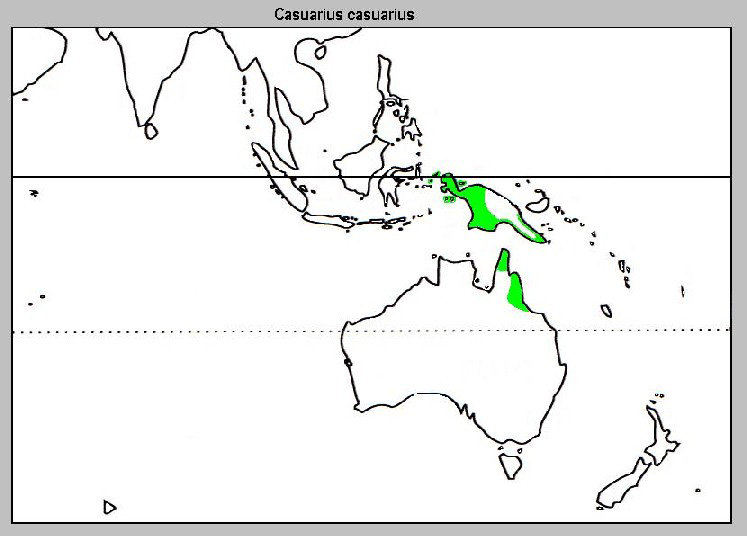
Poids et mesures
| Hauteur au garrot | de 130 à 170 cm |
|---|---|
| Longueur | 1,5 m |
| Poids | de 30 à 58 kg |
Données biologiques
| Durée de vie | 18 r |
|---|
Statut de conservation
| Menacé |
Description de l'animal
The Southern cassowary (Casuarius casuarius), often simply referred to as the cassowary, is a large, flightless bird that is native to the tropical rainforests of New Guinea, nearby islands, and northeastern Australia. This remarkable bird is one of the heaviest and most formidable avian species on Earth, second only to the ostrich in terms of weight and size. The Southern cassowary plays a crucial role in its ecosystem, acting as a keystone species in dispersing seeds throughout its habitat.Adult Southern cassowaries can stand up to 1.5 to 2 meters (5 to 6.6 feet) tall and weigh as much as 58.5 kilograms (129 pounds), with females generally being larger and more dominant than males. They are known for their striking appearance, which includes a deep black body, a vivid blue neck and head, and two red wattles hanging down from the neck. One of the cassowary's most distinctive features is the casque, a helmet-like structure made of keratin, sitting atop its head. The purpose of the casque is not fully understood, but it is thought to play a role in social dominance, feeding, and possibly in protection as the bird moves through dense vegetation.
The Southern cassowary has powerful legs that are equipped with three toes, each with sharp claws. The middle toe's claw can be up to 12 centimeters (4.7 inches) long and is capable of inflicting serious injuries, making the cassowary one of the few birds capable of killing humans and predators with a swift kick if cornered or threatened.
Cassowaries are solitary creatures, coming together only to mate. They are frugivores, primarily feeding on fruits that have fallen to the forest floor, although they will also consume fungi, invertebrates, and small vertebrates when the opportunity arises. Their diet plays a significant role in the rainforest ecosystem, as they are one of the few species capable of dispersing the seeds of large fruits, thus aiding in forest regeneration and biodiversity.
Breeding season for the Southern cassowary occurs between June and October. The female lays three to eight large, pale green-blue eggs in a simple nest on the ground, which is then solely tended by the male. He incubates the eggs for about 50 days and continues to care for the chicks for up to nine months, teaching them how to forage for food.
Despite their formidable appearance and capabilities, Southern cassowaries are listed as Vulnerable by the International Union for Conservation of Nature (IUCN). Their populations are threatened by habitat loss due to deforestation, vehicle strikes, dog attacks, and human encroachment. Conservation efforts are in place to protect these magnificent birds and their habitat, including the establishment of protected areas and the promotion of cassowary-friendly practices among local communities.
In summary, the Southern cassowary is a majestic, albeit potentially dangerous, bird with a critical role in its ecosystem. Its unique physical characteristics and behaviors have fascinated scientists and bird enthusiasts alike, underscoring the importance of preserving its habitat for future generations to marvel at and study.
Carte de répartition

Nouvelles photos d'animaux
Top 10 des animaux
- Dolphin gull (Leucophaeus scoresbii)
- Japanese macaque (Macaca fuscata)
- Greek tortoise (Testudo graeca)
- Stone loach (Barbatula barbatula)
- Russian tortoise (Testudo horsfieldii)
- Galápagos tortoise (Geochelone nigra complex)
- Diana monkey (Cercopithecus diana)
- Moustached guenon (Cercopithecus cephus)
- Common flying dragon (Draco volans)
- Galápagos penguin (Spheniscus mendiculus)